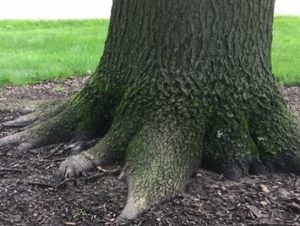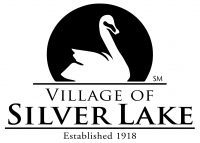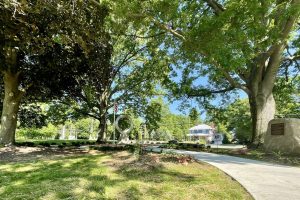Latest News/Updates
Silver Lake Village is raffling off a framed pastel painting to support The Silver Lake Shade Tree Commission’s (STC) “Pay the Shade Forward” program. This program helps residents add new trees to their property.
The piece is of a swan (entitled “Lift Off”), donated by local artist, Marcia Mandala.
Raffle Tickets are $10 per entry and available at Village Hall. Proceeds from the raffle will be used to purchase a tree for a lucky Silver Lake resident.
Visit the Shade Tree Commission’s table at the Silver Lake Garden Club Festival on July 20the to sign up for a chance at a new tree for your yard!
Our Mission
- To educate residents on the importance and benefits that trees have for our community
- To encourage residents to plant new trees on their own private properties, and to engage in proper tree care
- To maintain and replant street and park trees
Did You Know?
Silver Lake’s overall tree canopy is in trouble! A study in 2020 found that the Village’s tree canopy cover has diminished significantly in recent years. While the Village has the power to replant and properly maintain street trees on devil strips/tree lawns, this only accounts for less than 3 % of the Village’s canopy cover. The other 97 % of tree cover comes from residents private property. Therefore, we rely on our residents to plant and maintain trees on their own properties, to ensure that Silver Lake stays a beautiful, tree-lined, Tree City USA, a distinction that has been held since 1993.
Benefits of Trees
- Increase property values
- Reduce pollution
- Provide habitat to wildlife
- Reduce energy bills
- Reduce noise levels
- Reduce storm water runoff
What Can I Do To Help?
- Plant trees! Particularly types of trees that grow large and produce a lot of shade, like Oaks, Maples and Elms
- Practice proper mulching techniques (avoid volcano mulching)
- Have your trees pruned and properly cared for by certified arborists (and pruned while trees are dormant in winter)
- Monitor trees for signs of pests such as the Spotted Lantern Fly, Emerald Ash Borer, and Spongy Moth/Gypsy Moth (and report to the Shade Tree Commission if you spot any to curb infestation)
- Stop by our nursery behind Village Hall during our repotting event each fall for a FREE Sapling (dates/times will be posted)
- Request to have trees put on your devil strip/tree lawn for FREE from the Village’s Service Department at SD@villageofsilverlake.com (subject to availability)
Neighborhoods with fewer trees and tree canopies (pictured right) often have higher energy bills, increased risk of flooding,
and lower property/resale values, compared to neighborhoods with large shade trees and tree canopies (pictured left).
Street Tree Info
The Village is responsible for the ownership and maintenance of nearly 900 trees. Tree maintenance includes everything from planting, mulching, pruning, and removal.
Which Trees Are Owned By The Village?
- The trees on the devil strip/tree lawn are Village-owned trees. They are planted and maintained by the Village.
- On streets with no devil strip/tree lawn/sidewalk, the Village owns a portion of your front yard, referred to as the “right of way”. Ninety percent of this “right of way” is 25′ from the center of the street.
- Any trees located in the “right of way” space are Village-owned.
Who Is Responsible For Street Trees?
- The Service Department plants and prunes the devil strip trees and will remove these trees, when necessary.
- The Service Department creates the mulch beds around new trees and waters new trees.
- Homeowners maintain the devil strip/tree lawn area. This includes mowing the grass and weeding the mulch bed. If mulch is added, it should never be more than 2″ deep and away from the trunk flare. Learn more by clicking here.

Proper mulching exposes tree root flair for healthy growth.
For further questions, contact the Service Department at 330.923.5233.
Tree City USA
In 2023, the Village earned our 30th Tree City USA award. To receive this award, we must meet these 4 standards:
- A Tree Board or Department
- A Tree Care Ordinance
- An annual community forestry budget of at least $2 per capita
- An Arbor Day observance
Shade Tree Commission Members
John Gerrath, Chairperson, johngerrath@gmail.com
Robert Henry, henryrj@gmail.com
Sheri Petrosek, 330.603.2968, sheripetrosek@yahoo.com
Debra Sanderson, 330.690.7624, Debra.Sanderson@yahoo.com
Bill Braden, 330.928.7403, wjbraden08@gmail.com
Suzanne Garrett, Liaison to Council, sgarrett@villageofsilverlake.com
Advisors/Special Projects:
Ben Gregory (Service Department Liaison), 330.923.5233, SD@villageofsilverlake.com
Marcia Mandala, 330.414.4608, marciamandala@yahoo.com
Paul Theiss, 330.696.9235
Frequently Asked Questions:
- The Village removed a tree from my devil strip. Will it be replaced? The Service Department’s goal is to have every available planting site filled and follows a planting schedule.
- How can I have a Village-owned tree planted on my devil strip/tree lawn/right of way? Contact the Service Department with your request.
- How do I have a tree planted in memory of a loved one? Visit the Park Board page (here) to learn about Memorial Tree Donations.
Tree Inventory:
Every autumn the Tree Commission inventories 1/5 of the Village-owned trees, assessing tree health, growth, and maintenance needs.
This data is collected and utilized by the Service Department to help maintain a healthy canopy.
Shade Tree Commission Ordinance:
This Ordinance establishes an advisory board to promote the regulation and control of the planting and maintenance of trees and shrubs on Village property, such as tree lawns, Fauser Arboretum, and street islands. Click here to read the Ordinance.
Commission Meetings:
The first Thursday of January, March, May, July, September, and November at 4:00 p.m. at Village Hall. All are welcome to attend.


